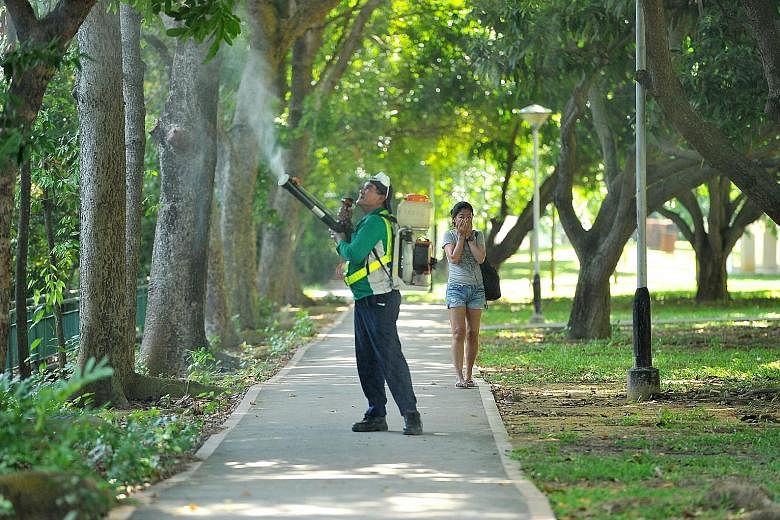For many of those involved in dealing with Singapore's first Zika outbreak in August, the news did not come as a surprise.
Communicable Diseases Centre clinical director Leo Yee Sin said that even before her team at the centre saw the first patients, they were already telling one another to watch out for Zika.
"We knew that the big one would come," said Professor Leo.
"This was confirmation."
The beginning of the outbreak was in late August, when doctors at Sims Drive Medical Clinic noticed an unusual spike in patients with fever, rashes and joint pain.
It looked like dengue, but it was not. The doctors contacted the Ministry of Health (MOH), and by the end of the week, it was official - Zika had reached Singapore.
The days that followed passed in a blur for those who worked around the clock to make sense of the rapidly changing situation.
Prof Leo and her colleagues were gearing up to receive the patients they knew would soon arrive.
Ms Constance Low and Ms Lalitha Kurupatham, from MOH's communicable diseases division, were working hard to connect the dots.
"We were lucky in that sense," said Ms Lalitha, a senior assistant director for surveillance and response. "It wasn't a new disease that dropped in our laps - like in 2003, with Sars."
Sars refers to severe acute respiratory syndrome. It took the lives of 33 people in Singapore. Another 205 people fell sick.
Meanwhile, Dr Cui Lin, a principal scientific officer at the National Public Health Laboratory, was working with her team to test samples as quickly as possible.
Dr Cui remembers grimacing when her team received the box of 160 blood and urine samples from a construction site.
"You can imagine how messy it was, after the construction workers were asked to take the urine samples themselves," Dr Cui said.
In August, the first few days of the outbreak kept everyone busy, especially at the laboratory, where work became almost like that at a production line.
One person would try and decipher what was written on the sample containers, another would extract genetic material and a third would carry out the testing.
"It was like we were factory workers," said Mr Tom Yen, a medical technologist.
"Most of the time, before we finished one batch, the next batch was already here."
Ms Low, a senior public health officer, also recalled how much care and tact they had to exercise when speaking to Zika-positive pregnant women, who were the most anxious of the lot.
The mosquito-borne disease is known to cause abnormally small heads in babies whose mothers were infected while pregnant - a condition called microcephaly.
Ms Low said: "In most of the phone calls, they asked us a lot of questions before they started answering any of ours."
While Zika numbers have tapered off in recent weeks - no new Zika cases have been reported since Dec 11 - there is much about the virus that remains to be discovered.
Prof Leo said she is hoping to study, at regular intervals over the next two years, those who contract Zika to understand the disease's impact over a long period of time.
This is important because mosquito-borne diseases such as Zika, dengue and chikungunya tend to make the body react in similar ways.
If someone was infected by the dengue virus in the past, for example, it can make it harder for doctors to tell if that person has Zika.
Another puzzling aspect of the disease: Why have sporadic Zika reports emerged in other parts of the region over the decades, but seemed to have disappeared again?
There have been reports of travellers to South-east Asia who fell ill and were diagnosed with Zika back home, Prof Leo said.
She said: "If travellers spending a short period of time in these countries went home with infections, there must be local transmission. So, why don't local residents seem to be affected by this disease?
"And it is the same question we are asking here - is Zika really new in Singapore?"
REVISITING GROUND ZERO

THE SITE
The Sims Urban Oasis condominium worksite at 60, Sims Drive. Thirty-seven cases of Zika virus emerged from the construction site. It was ordered to stop work on Aug 27, and misting and thermal fogging were conducted.

THE DOCTORS
Sims Drive Medical Clinic doctors (from left) Lim Chien Chuan, Tan May Yen and Chi Wei Ming were the first to sound the alert on Zika. They spotted a pattern emerging among patients who came in with similar symptoms.

THE CAMPAIGN
Posters with information on Zika at the lift lobby of Block 102, Aljunied Crescent - home of the first locally infected victim. NEA officers also went around the area distributing leaflets and insect repellent.


